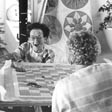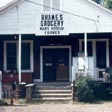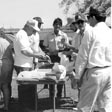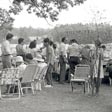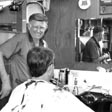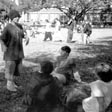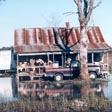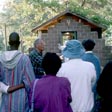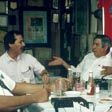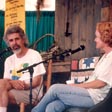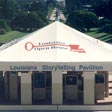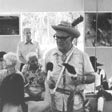Swapping Stories in Louisiana
By Maida Owens and Carl Lindahl
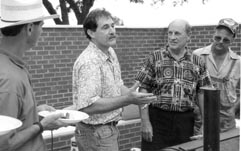
Not since the early 1940s has American storytelling enjoyed such popularity as it does today. Unfortunately, as in the days of the Depression-era Federal Writers Project, when a small army of regional writers went forth to collect tales from the field, many of today's storytelling enthusiasts are often more interested in artful renderings than in recounting the tales as they found them. Their recreations are often quite popular with audiences such as those that gather for the National Storytelling Festival , but can do a disservice to the artistry of the tellers from whom they collected. Folklorists, on the other hand, can sometimes be so intent on being faithful to the tellers that they leave the general public behind. The effort to combine the goals of contemporary folklorists with that of reaching a wide audience interested in the art of storytelling has created a massive project in Louisiana which culminates in a new book, Swapping Stories: Folktales from Louisiana.
The project had its roots in the Louisiana Storytelling Program, one of four major components of Louisiana Open House 1990, a statewide promotional effort initiated by the Office of Tourism. The Open House itself was a pioneering effort to attempt to forge a collaboration between the Louisiana Folklife Program and the Office of Tourism, sister agencies with different goals but which saw possible common interests in creating sustainable growth through cultural tourism. While both the Open House and the Storytelling Program were controversial in some circles, the latter project did bring the two agencies and eighty-seven organizations together to create a traveling storytelling pavilion and a format which provided communities assistance in identifying their storytellers and presenting them to local and visiting audiences.
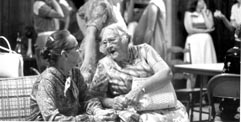
Starting in September of 1989, Maida Owens, director of the Louisiana Folklife Program, agreed to direct the Office of Tourism initiative, acting as a central resource person, providing information about the regions, folk artists already documented, cultural organizations, contacts, and as moral support for the team of nine regional coordinators. These regional coordinators trained the eighty-seven local coordinators regarding program development and identification of storytellers, stressing the importance of a moderator and the difference between storytellers who work from their own culture and those with theatrical backgrounds who borrow and embellish the traditions of others.
Fortunately, most communities chose to present folk storytellers or local lay historians. These tellers were pleased to be invited to share their knowledge of local culture with friends and guests. Storytelling was defined as any oral tradition including fictive stories (tales) and those which were told as true (personal narratives, local legends, tall tales, etc.). Sessions might cover a narrow theme such as memories of Huey Long or accounts of buried treasure, or they might present a variety of topics. Tales focusing on local traditions were especially popular. In all, 1,051 storytellers participated in 504 different storytelling sessions, and 441 of the stories were recorded and preserved in an archive.
In creating the book, Swapping Stories, the editors transcribed the stories told on public stages and supplemented these with more intimate tellings from private homes, barbershops, cookouts, and other places where Louisiana's folktales are commonly told today. From these multiple sources were winnowed more than two hundred tales from some of Louisiana's finest storytellers. Together they form a comprehensive volume of transcriptions in many genres including ghost stories, tall tales, political anecdotes, animal tales, myths, magic tales, buried treasure tales, and reminiscences of small-town life. Tales came from all regions of the state and where the tellers language was other than English, the tale was offered both in translation and in its original language.
Among the storytellers included in the book, are several who will be featured at this year's Louisiana Folklife Festival. Enola Matthews, a black Creole now living in Jennings, was born and raised near Durald. Her grandfather came to New Orleans from Ireland at the age of five, and he and his family brought with them wonderful magic tales with which he would eventually regale his grandchildren. Although she was only ten when her grandfather died, Enola still recounts his tales some seventy years later. She is also an accomplished quilter. Both Sarah and Robert Albritton, are as well known around Ruston for their North Louisiana African-American cooking as for their fine stories. David Allen of Homer can weave a tall tale or animal tale as he carves one of his highly-prized African-American walking sticks which in turn become both occasions for tales and visual representations of tale motifs. Bertney Langley, like his uncle the late Bel Abbey, is a gifted teller of tales from the Koasati community of Elton, Louisiana. Irvan Perez has won the National Heritage Award for his role in preserving the traditions of the Isleños, the descendants of Canary Islanders. Besides his stories, he is equally noted for his wild fowl decoys and for his singing of décimas, the narrative songs in Spanish which are a cultural marker for all Isleño people.
The companion video by the same name is a 30 minute documentary was produced by Maida Owens and Pat Mire. Louisiana Public Broadcasting has a website that expands on the documentary, Swapping Stories.
Video Clips from the Documentary
Alligator Peach Tree, Pierre Daigle, Church Point, Louisiana
For a transcription, click here.
Bouki, Lapin et Rat de Bois (Bouki, Lapin and Possum), Enola Matthews, Jennings, Louisiana
For a transcription, click here.
How the Bat Got Its Wings, Bertney Langley, Elton, Louisiana
For a transcription, click here.
I'm Going to Leave You, Chère, Harry Lee Leger, Eunice, Louisiana
For a transcription, click here.
Swapping Stories, Dave Petitjean and A.J. Smith, Crowley and Lake Charles, Louisiana
For a transcription, click here.
For more information about the publication Swapping Stories: Folktales from Louisiana, click here.


